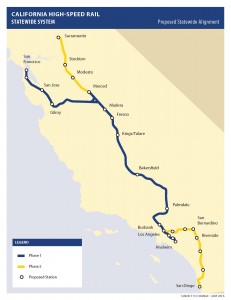Cap-And-Trade Extension A Lifeline For High Speed Rail
Auction proceeds will continue to fund the train and other transit, housing and energy programs
As Cara posted, the California Legislature scored a super-majority victory last night to extend the state’s signature cap-and-trade program through 2030. It was a rare bipartisan vote, although it leaned mostly on Democrats.
 Lost in the politics is what this means for high speed rail. The system has a fixed and dwindling amount of federal and state funds at this point, and it’s relying on continued funding from the auction of allowances under cap-and-trade to build the first segment from north of Bakersfield to San Jose and San Francisco.
Lost in the politics is what this means for high speed rail. The system has a fixed and dwindling amount of federal and state funds at this point, and it’s relying on continued funding from the auction of allowances under cap-and-trade to build the first segment from north of Bakersfield to San Jose and San Francisco.
If the auction was declared invalid or ended at 2020 with depressed sales, the system would be in major jeopardy of collapsing before construction even finished on the first viable segment. Now it has some assurance of access to funds.
But of course it’s not that simple. The bill that passed yesterday has diminished available auction funds set aside for the programs that have been funded to date with cap-and-trade dollars. As part of the political compromises, more auction money will now go to certain carve-outs, like to backfill a now-canceled program for wildfire fees on rural development, as Eric noted.
And another compromise may put a ballot measure before the voters, passage of which would require a two-thirds vote for any legislative spending plan for these funds going forward. That means Republicans — who generally hate high speed rail — would be empowered to veto future spending proposals.
Still, high speed rail once again has a lifeline, as do the other programs funded by cap-and-trade, such as transit improvements, weatherization, and affordable housing near transit. It’s an additional victory beyond the emissions reductions that will take place under this extended program.
Reader Comments
2 Replies to “Cap-And-Trade Extension A Lifeline For High Speed Rail”
Comments are closed.







This is what critics of this project warned about way back in 2010: the state would use money needed for other worthwhile projects just to keep this poorly-conceived, unfunded project on life support:
“This is a dangerous time for the CHSR project since its assumed financing sources have not materialized. The Federal grant funds and AB3034-initiated GO bonds, if buyers for those bonds can be found, bring the project’s available capital to about 11% of what it needs for Phase 1. But there are no known local government and no private sector monies in the project at present. New federal grants will be a fraction of the Obama Administration’s FY 2010 bold plans. The CHSRA could be desperate for funds to keep their project alive and the temptation to promise more than the law allows. Without the money, and with diminishing confidence in the CHSRA’s plans, this becomes a dangerous time to risk the State of California’s financial future.”
http://www.cc-hsr.org/assets/pdf/6CHSRFinancialRisks101210.pdf
This study was written before the cap and trade began draining into this dumb project. Jerry Brown’s legacy: That financial drain will apparently continue, even though cap and trade revenue will never be nearly enough to finish building the project.
Ethan said;
“……Still, high speed rail once again has a lifeline, as do the other programs funded by cap-and-trade, such as transit improvements, weatherization, and affordable housing near transit…..”
Dear Ethan,
Your commentary indicates that the integrity of discourse on Legal Planet continues to improve as we abandon the false and misleading notion of “climate mitigation.” Nowhere in your commentary is climate mitigation mentioned, and no connection is drawn to the cap n’ trade auction and high speed rail. Ethics matter, thanks for honesty about climate mitigation.
How much is a California Carbon Credit worth in terms of climate mitigation? Not much. High speed rail, weatherization and affordable housing may have to wait until mankind figures out how to actually mitigate the earth’s climate.